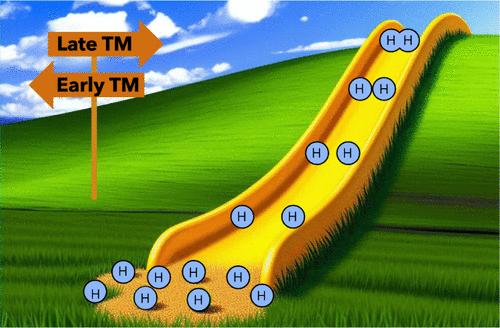当前位置:
X-MOL 学术
›
J. Phys. Chem. C
›
论文详情
Our official English website, www.x-mol.net, welcomes your
feedback! (Note: you will need to create a separate account there.)
Atomic Hydrogen Interaction with Transition Metal Surfaces: A High-Throughput Computational Study
The Journal of Physical Chemistry C ( IF 3.3 ) Pub Date : 2024-11-16 , DOI: 10.1021/acs.jpcc.4c06194 Miquel Allés, Ling Meng, Ismael Beltrán, Ferran Fernández, Francesc Viñes
The Journal of Physical Chemistry C ( IF 3.3 ) Pub Date : 2024-11-16 , DOI: 10.1021/acs.jpcc.4c06194 Miquel Allés, Ling Meng, Ismael Beltrán, Ferran Fernández, Francesc Viñes

|
Hydrogen adatoms are involved in many reactions catalyzed by Transition Metal (TM) surfaces, such as the Haber–Bosch process or the reverse water gas shift reaction, key to our modern society. Any rational improvement on such a catalyst requires an atomistic knowledge of the metal↔hydrogen interaction, only attainable from first-principles calculations on suited, realistic models. The present thorough density functional theory study evaluates such H interaction at a low coverage on most stable surfaces of bcc, fcc, and hcp TMs. These are (001), (011), and (111) for bcc and fcc TMs and (0001), (101̅0), and (112̅0) for hcp, covering 27 TMs and 81 different TM surfaces in total. In general terms, the results validate, while expanding, previous assessments, revealing that TM surfaces can be divided into two main groups, one in the majority where H2 would be thermodynamically driven to dissociate into H adatoms, located at heights of ∼0.5 or ∼1.0 Å, and another for late TMs, generally with a d10 electronic configuration, where H2 adsorption with no dissociation would be preferred. No trends in H adsorption energies are found down the groups, but yes along the d series, with a best linear adjustment found for the d-band center descriptor, especially suited for close-packed fcc and hcp TMs surfaces, with a mean absolute error of 0.15 eV. Gibbs free adsorption energies reveal a theoretical volcano plot where fcc TMs are best suited, but with peak Pt performance displaced due to dispersive force inclusion in the method. Still, the volcano plot with respect to the experimental logarithm of the exchanged current density polycrystalline data is far from being valid for a quantitative assessment, although useful for a qualitative screening and to confirm the trends computationally observed.
中文翻译:

原子氢与过渡金属表面的相互作用:一项高通量计算研究
氢原子参与过渡金属 (TM) 表面催化的许多反应,例如 Haber-Bosch 工艺或反向水煤气变换反应,这对我们现代社会至关重要。对这种催化剂的任何合理改进都需要对金属↔氢相互作用有原子知识,这只能通过合适的现实模型的第一性原理计算来实现。目前全面的密度泛函理论研究在 bcc、fcc 和 hcp TM 的大多数稳定表面上评估了这种 H 相互作用。它们是 (001)、(011) 和 (111) 用于 bcc 和 fcc TM,以及 (0001)、(101̅0) 和 (112̅0) 用于 hcp,总共涵盖 27 个 TM 和 81 个不同的 TM 表面。一般来说,结果验证了,同时扩展了以前的评估,揭示了 TM 表面可以分为两个主要组,一个是其中 H2 会被热力学驱动解离成位于 ∼0.5 或 ∼1.0 Å 高度的 H 原子,另一个用于晚期 TM,通常具有 d10 的电子构型, 其中,无解离的 H2 吸附将是首选。在各组下没有发现 H 吸附能的趋势,但沿 d 系列发现有趋势,为 d 波段中心描述符找到了最佳线性调整,特别适用于紧密堆积的 fcc 和 hcp TMs 表面,平均绝对误差为 0.15 eV。吉布斯自由吸附能揭示了一个理论火山图,其中 fcc TMs 最适合,但由于方法中包含色散力,峰值 Pt 性能被取代。 尽管如此,关于交换电流密度多晶数据的实验对数的火山图对于定量评估远非有效,尽管对于定性筛选和确认计算观察到的趋势很有用。
更新日期:2024-11-16
中文翻译:

原子氢与过渡金属表面的相互作用:一项高通量计算研究
氢原子参与过渡金属 (TM) 表面催化的许多反应,例如 Haber-Bosch 工艺或反向水煤气变换反应,这对我们现代社会至关重要。对这种催化剂的任何合理改进都需要对金属↔氢相互作用有原子知识,这只能通过合适的现实模型的第一性原理计算来实现。目前全面的密度泛函理论研究在 bcc、fcc 和 hcp TM 的大多数稳定表面上评估了这种 H 相互作用。它们是 (001)、(011) 和 (111) 用于 bcc 和 fcc TM,以及 (0001)、(101̅0) 和 (112̅0) 用于 hcp,总共涵盖 27 个 TM 和 81 个不同的 TM 表面。一般来说,结果验证了,同时扩展了以前的评估,揭示了 TM 表面可以分为两个主要组,一个是其中 H2 会被热力学驱动解离成位于 ∼0.5 或 ∼1.0 Å 高度的 H 原子,另一个用于晚期 TM,通常具有 d10 的电子构型, 其中,无解离的 H2 吸附将是首选。在各组下没有发现 H 吸附能的趋势,但沿 d 系列发现有趋势,为 d 波段中心描述符找到了最佳线性调整,特别适用于紧密堆积的 fcc 和 hcp TMs 表面,平均绝对误差为 0.15 eV。吉布斯自由吸附能揭示了一个理论火山图,其中 fcc TMs 最适合,但由于方法中包含色散力,峰值 Pt 性能被取代。 尽管如此,关于交换电流密度多晶数据的实验对数的火山图对于定量评估远非有效,尽管对于定性筛选和确认计算观察到的趋势很有用。


















































 京公网安备 11010802027423号
京公网安备 11010802027423号